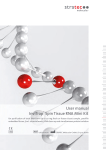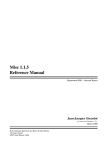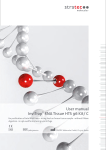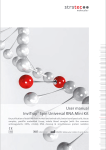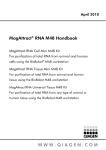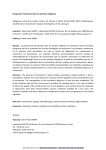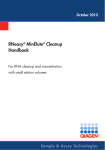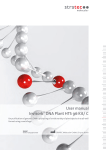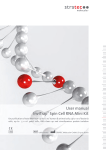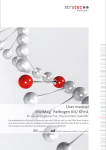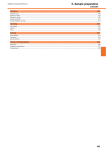Download InviTrap Spin Plant RNA Mini Kit User manual
Transcript
User manual InviTrap® Spin Plant RNA Mini Kit for purification of total RNA from plant material and -cells (up to 100 mg or 1 x 107 cells) as well as from filamentous fungi REF 1064100x0 STRATEC Molecular GmbH, D-13125 Berlin Instruction for the InviTrap® Spin Plant RNA Mini Kit The InviTrap® Spin Plant RNA Mini Kit is qualified for the isolation of high quality total RNA from plant cells or plant tissues and filamentous fungi (up to 100 mg or 1 x 107 cells) in a spin filter format. Special buffer conditions guarantee an efficient lysis of the starting material and a simultaneous inactivation of endogenous RNases. Genomic DNA is almost separated from the total RNA by binding to specially optimized mineral carrier particles during the lysis. These particles are included in the Lysis Buffer. Multiple samples can be processed simultaneously in less than 1 hour. The kit can be used further for simultaneous isolation of total RNA and proteins. DNase-digestion to remove contaminating genomic DNA is not necessary. The InviTrap® Spin Plant RNA Mini Kit is intended for life science research use only. Prior to using it for other purposes, the user must validate the system in compliance with the applicable law, directives, and regulations. The kit is neither validated for the isolation of total RNA from serum, plasma, blood, tissue, human or animal cell culture, bacteria or yeast cells nor for viruses. The performance of the kit in isolating and purifying total RNA from fecal samples has not been evaluated. ® ® Trademarks: InviTrap , Eppendorf . Registered marks, trademarks, etc. used in this document, even when not specifically marked as such, are not to be considered unprotected by law. ® The Invisorb technology is covered by patents and patent applications: US 6,110363, US 6,043,354, US 6,037,465, EP 0880535, WO 9728171, WO 9534569, EP 0765335, DE 19506887, DE 10041825.2, WO 0034463. ® ® InviTrap and Invisorb are registered trademarks of STRATEC Biomedical AG. The PCR process is covered by US Patents 4,683,195, and 4,683,202 and foreign equivalents owned by Hoffmann-La Roche AG. © 2015 STRATEC Molecular, all rights reserved. 2 InviTrap® Spin Plant RNA Mini Kit 0515 Contents Kit contents of the InviTrap® Spin Plant RNA Mini Kit 4 Symbols 5 Storage 5 Quality control 5 Intended use 6 Product use Limitation 6 Safety information 7 Product characteristics of the InviTrap® Spin Plant RNA Mini Kit 8 Principle and procedure 10 Sampling and storage of starting material 10 Sample homogenization 10 Procedure 11 Lysis 11 Binding and removal of DNA 12 Binding total RNA 12 Removing residual contaminants 12 Elution 12 Important notes 13 Important points before starting a protocol 13 Preparing reagents and buffers 13 Equipment and reagents to be supplied by user 15 Scheme 16 Instructions 17 7 Protocol 1: Total RNA extraction from plant cells (1x10 ) or plant tissues and filamentous fungi (max. 100 mg) 17 Supplemental protocol for DNA digestion on the RTA Spin Filter 19 Supplemental Protocol for simultaneous isolation of RNA and proteins 20 Troubleshooting q 21 Appendix 23 General notes on handling RNA 23 Storage of RNA 24 Quantification of RNA 24 Purity of RNA 24 Ordering information 27 3 InviTrap® Spin Plant RNA Mini Kit 0515 Kit contents of the InviTrap® Spin Plant RNA Mini Kit Store 1 M DTT (not provided) at - 20°C! All other kit components are stable at room temperature (RT)! 6 total RNA extractions Catalogue No. 50 total RNA extractions 250 total RNA extractions 1064100100 1064100300 1064100400 Lysis Solution DCT 4 ml (only for 3 extractions) 50 ml 250 ml Lysis Solution RP 4 ml (only for 3 extractions) 50 ml 250 ml Wash Buffer R1 15 ml (ready to use) 20 ml (final volume 40 ml) 80 ml (final volume 160 ml) Wash Buffer R2 15 ml (ready to use) 2 x 12 ml (final volume 2 x 60 ml) 2 x 50 ml (final volume 2 x 250 ml) Elution Buffer R 2 ml 2 x 2 ml 30 ml Prefilter 6 50 5 x 50 RTA Spin Filter Set 6 50 5 x 50 2.0 ml Receiver Tubes 6 50 5 x 50 Elution Tubes 6 50 5 x 50 Manual 1 1 1 Initial steps Add 20 ml 96-100% ethanol to the bottle Wash Buffer R1. Add 80 ml 96-100% ethanol to the bottle Wash Buffer R1. Add 48 ml 96-100% ethanol to each bottle Wash Buffer R2. Add 200 ml 96-100% ethanol to each bottle Wash Buffer R2. Adjust Lysis Solution DCT or Lysis Solution RP with 1/100 volume of 1M DTT or β-Mercaptoethanol. Due to the instability of dissolved DTT or βMercaptoethanol, under oxidative conditions do not mix the whole Lysis Solutions with DTT or β-Mercaptoethanol, in case of the kits with 50 and 250 preparations we recommend the preparation of a volume DTT- or βMercaptoethanol. Containing Lysis Solution shortly before carrying out the purifications adapted to the number of samples that will be processed. Store the remaining Lysis Solution DCT/ Lysis Solution RP and DTT or βMercaptoethanol separately in accordance to the storage instructions (see “Storage”, page 5). It is possible to replace DTT by β-Mercaptoethanol. In that case adjust Lysis Solution DCT/ Lysis Solution RP with 1/100 volume of β-Mercaptoethanol as described above. 4 InviTrap® Spin Plant RNA Mini Kit 0515 Symbols Manufacturer Lot number Catalogue number Expiry date Consult operating instructions Temperature limitation Do not reuse Storage All buffers, except the 1 M DTT solution, and kit components of the InviTrap® Spin Plant RNA Mini Kit should be stored well sealed and dry at room temperature (RT) and are stable for at least 12 months under these conditions. Store the 1 M DTT solution at - 20°C to prevent oxidative damage. Under this condition the solution of 1 M DTT is stable for 12 months. If the kit components are consumed in more than one run it is recommended to aliquot the 1 M DTT solution and minimize the number of freezing and thawing cycles. Wash Buffer R1 and R2 charged with ethanol should be appropriate sealed. Before every use make sure that all components have room temperature. If there are any precipitates within the provided solutions solve these precipitates by warming carefully. Room temperature (RT) is defined as range from 15 - 30°C. Quality control and product warranty STRATEC Molecular warrants the correct function of the InviTrap® Spin Plant RNA Mini Kit for applications as described in this manual. Purchaser must determine the suitability of the Product for its particular use. Should any Product fail to perform the applications as described in the manual, STRATEC Molecular will check the lot and if STRATEC Molecular investigates a problem in the lot, STRATEC Molecular will replace the Product free of charge. STRATEC Molecular reserves the right to change, alter, or modify any Product to enhance its performance and design at any time. In accordance with STRATEC Molecular’s ISO 9001-2000 and ISO EN 13485 certified Quality Management System the performance of all components of the InviTrap® Spin Plant RNA Mini Kit have been tested separately against predetermined specifications routinely on lot-to-lot to ensure consistent product quality. If you have any questions or problems regarding any aspects of InviTrap® Spin Plant RNA Mini Kit or other STRATEC Molecular products, please do not hesitate to contact us. A copy of STRATEC Molecular’s terms and conditions can be obtained upon request or are presented at the STRATEC Molecular webpage. For technical support or further information please contact: from Germany: +49-(0)30-9489-2901/ 2910 from abroad: +49-(0)30-9489-2907 or contact your local distributor. 5 InviTrap® Spin Plant RNA Mini Kit 0515 Intended use The InviTrap® Spin Plant RNA Mini Kit is the ideal tool for reliable and fast manual isolation and purification of high quality total RNA from up to 100 mg or 1 x 107 cells of plant material or filamentous fungi. For reproducible high yields an appropriate sample storage and quick operation under the rules for RNA operation is essential. The purified RNA is ready to use. The isolation protocol and all buffers are optimized to assure a high yield as well as a high purity of purified total RNA. All manual work is reduced to a minimum. With the InviTrap® procedure, all RNA molecules longer than 200 nucleotides are purified. The procedure provides enrichment for mRNA since most RNAs <200 nucleotides are selectively excluded. The size distribution of the purified RNA is comparable to that obtained by centrifugation through a CsCl cushion, where small RNAs do not sediment very efficiently. For some studies a simultaneous investigation of the RNA and of the cell specific proteins is necessary. The kit includes an isolation protocol of RNA and intracellular proteins from the same sample. THE PRODUCT IS INTENDED FOR USE BY PROFESSIONALS ONLY, SUCH AS TECHNICIANS, PHYSICIANS AND BIOLOGISTS TRAINED IN MOLECULAR BIOLOGICAL TECHNIQUES. It is designed to be used with any downstream application employing enzymatic amplification or other enzymatic modifications of RNA followed by signal detection or amplification. Any diagnostic results generated by using the sample preparation procedure in conjunction with any downstream diagnostic assay should be interpreted with regard to other clinical or laboratory findings. To minimize irregularities in diagnostic results, adequate controls for downstream applications should be used. Product use limitation The kit is neither validated for the isolation of total RNA from serum, plasma, blood, human or animal cell culture or tissue, bacteria or yeast cells, nor for viruses. The performance of the kit in isolating and purifying total RNA from fecal samples has not been evaluated. The kit was not tested on its ability to desalinate RNA or for RNA purification from enzymatic reactions, like Proteinase digestion, RNA ligation or labeling reactions. The included chemicals are only useable once. Differing of starting material or flow trace may lead to inoperability; therefore neither a warranty nor guarantee in this case will be given, neither implied nor express. The user is responsible to validate the performance of the STRATEC Molecular Product for any particular use. STRATEC Molecular does not provide for validation of performance characteristics of the Product with respect to specific applications. STRATEC Molecular Products may be used e.g.in clinical diagnostic laboratory systems conditioned upon the complete diagnostic system of the laboratory the laboratory has been validated pursuant to CLIA’ 88 regulations in the U.S. or equivalents in other countries. All Products sold by STRATEC Molecular are subject to extensive quality control procedures (according to ISO 9001-2000 and ISO EN 13485) and are warranted to perform as described herein. Any problems, incidents or defects shall be reported to STRATEC Molecular immediately upon detection thereof. The chemicals and the plastic parts are for laboratory use only; they must be stored in the laboratory and must not be used for purposes other than intended. The Product with its contents is unfit for consumption 6 InviTrap® Spin Plant RNA Mini Kit 0515 Safety information When and while working with chemicals, always wear a suitable lab coat, disposable gloves, and protective goggles! Avoid skin contact! Adhere to the legal requirements for working with biological material! For more information, please consult the appropriate material safety data sheets (MSDS). These are available online in convenient and compact PDF format at www.stratec.com for each STRATEC Molecular Product and its components. If buffer bottles are damaged or leaking, WEAR GLOVES, AND PROTECTIVE GOGGLES when discarding the bottles in order to avoid any injuries. STRATEC Molecular has not tested the liquid waste generated by the InviTrap® Spin Plant RNA Mini Kit procedures for residual infectious materials. Contamination of the liquid waste with residual infectious materials is highly unlikely, but cannot be excluded completely. Therefore, liquid waste must be considered infectious and be handled and discarded according to local safety regulations. European Community risk and safety phrases for the components of the InviTrap® Spin Plant RNA Mini Kit to which they apply, are listed below as follows Lysis Solution DCT Lysis Solution RP contains: Guanidinthiocyanate warning (H302-312-332-412 EUH032 P273) contains: Guanidinhydrochloride warning H302-315-319 P280-305-351-338 Wash Buffer R1 contains: Guanidinthiocyanate warning (H302-312-332-412 EUH032 P273) H302 H312 H315 H319 H332 H412 EUH032 P273 P280 P305-351-338 Harmful if swallowed Harmful in contact with skin Causes skin irritation Causes serious eye irritation Harmful if inhaled Harmful to aquatic life with long lasting effects. Contact with acids liberates very toxic gas. Avoid release to the environment Wear protective gloves/protective clothing/eye protection/face protection. IF IN EYES: Rinse cautiously with water for several minutes. Remove contact lenses, if present and easy to do. Continue rinsing. Emergency medical information can be obtained 24 hours a day from infotrac: outside of USA: in USA : 1 – 352 – 323 – 3500 1 – 800 – 535 – 5053 7 InviTrap® Spin Plant RNA Mini Kit 0515 Product characteristics of the InviTrap® Spin Plant RNA Mini Kit Starting material 7 up to 100 mg or 1x10 cells of plant material or filamentous fungi Yield up to 80 µg total RNA from 100 mg of Oryza sativa cotyledons Time Ratio about 15 minutes after lysis of the starting material A260 : A 280 1.6 - 2.0 The InviTrap® procedure represents a well-established technology for RNA purification. This technology combines the selective binding properties of a silica-based membrane with the speed of microspin technology. The InviTrap® Spin Plant RNA Mini Kit provides a fast and efficient way for reliable isolation of high quality total RNA from up to 100 mg or 1x107 cells of plant material or filamentous fungi. Up to 100 mg of sample is homogenized in liquid nitrogen and then lysed under highly denaturing conditions. The provided lysis buffers (Lysis Solution DCT/ Lysis Solution RP) of the InviTrap® Spin Plant RNA Mini Kit are adapted to the special requirements for the lysis of plant material from different species or different parts of the same plant. Plant material shows a high diversity in its composition and the content of secondary metabolites. The total RNA isolation combines efficient lysis and homogenization of the starting material in the presence of a highly denaturing guanidinethiocyanate containing buffer which immediately inactivates RNases to ensure purification of intact RNA with the efficient removal of the genomic DNA. The genomic DNA is fixed at the surface of the nucleic acid binding mineral carrier particles within the Lysis Solution DCT or Lysis Solution RP simultaneously to the cell lysis. Selective binding of the DNA is assured by optimized buffer conditions that reduce the undesired binding of the RNA to a minimum. Some secondary metabolites of plants are able to bind to the DNA-binding carrier particles and block the interaction with the DNA. Thus the complete DNA removal can be disturbed. To avoid this effect Lysis Solution DCT is optimized for plant material showing a high polysaccharide concentration and Lysis Solution RP is adapted to plant material with high phenol content (see page 13). Depending on the content and type of secondary metabolites in some plant materials or mycelia of filamentous fungi guanidine thiocyanate can cause solidification of the sample. Therefore the use of Lysis Buffer RP is recommended. During the lysis procedure under permanent shaking the carrier material is also shearing high molecular components, homogenizing the plant material and reducing the viscosity. After lysis the mineral carrier particles loaded with the genomic DNA are removed by centrifugation. Ethanol is added to provide appropriate binding conditions, and the sample is then applied to an RTA Spin Filter where the total RNA binds to the membrane and contaminants are efficiently washed away by repeated wash steps. The purified total RNA can be eluted in a small volume of RNase free water. The isolated total RNA is ready to use and should be stored at - 80°C. If the subsequent RNA applications show a high sensitivity to small DNA contaminations an optional DNase digestion is recommended The extracted RNA contains enriched mRNA. The particle size distribution of purified RNA is similar to those, gained using a CsCl - gradient. 8 InviTrap® Spin Plant RNA Mini Kit 0515 Due to the high purity, the isolated total RNA is ready to use for a broad panel of downstream applications like: ○ ○ ○ ○ ○ ○ ○ Northern Blotting, RNA dot blots, cDNA-library, in vitro translation, RT-PCR*, DDRT-PCR*, or TaqMan® analysis and array technologies. The purification procedure is rapid and does not require a phenol / chloroform extraction. Only a minimum of manual work by the user is necessary. The procedure is designed to avoid sampleto-sample cross-contaminations. Traditional time-killing procedures can be replaced using the InviTrap® Spin Plant RNA Mini Kit. If you are interested in using the kit on a laboratory workstation, please do not hesitate to contact our technical support (++49 (0)30-9489-2907). STRATEC Molecular also offers a system for the purification of RNA from plant material in a 96 well format. The InviTrap® RNA Plant HTS 96 Kit / C is designed for centrifuge use, the InviTrap® RNA Plant HTS 96 Kit / V for use in combination with the InviTrap® 96 Vacuum Manifold. The InviTrap® RNA Plant HTS 96 Kit / R has been developed for use on a 96 well format using laboratory workstation. For technical support or further information please contact: +49-(0)30-9489-2901/ 2907/ 2910 or your local distributor. * The PCR process is covered by US Patents 4,683,195, and 4,683,202 and foreign equivalents owned by Hoffmann-La Roche AG. 9 InviTrap® Spin Plant RNA Mini Kit 0515 Principle and procedure The InviTrap® Spin Plant RNA Mini Kit procedure comprises the following steps: ○ ○ ○ ○ ○ ○ ○ disruption and homogenization of the plant material cell lysis selective binding of the genomic DNA to a specific carrier and separation of contaminating DNA on the surface of the DNA binding mineral carrier particles transfer of the remaining sample into the RNA binding RTA Spin Filter, followed by the adjustment of the binding conditions binding of the total RNA to the membrane, while proteins remain in the filtrate washing of the membrane and elimination of contaminants and ethanol elution of highly pure total RNA Repeated wash steps make sure that contaminations and enzyme inhibitors are efficiently removed and high purified RNA is eluted in Elution Buffer R or RNase free water. This manual contains 1 protocol (+ 2 supplemental for protocols) (17-20). Sampling and storage of starting material Best results are obtained using fresh plant material. As long as samples are not shock frosted or are incubated with RNase inhibitors or denaturing reagents, the RNA is not secured. Therefore it is essential, that cells are immediately flash frozen after cell harvest and are stored at - 80°C. RNA from deep frozen samples is stable for months. Frozen tissue should not be allowed to thaw while handling. RNA purification should be processed as soon as possible. Cells can be stored also in Lysis Solution DCT/ Lysis Solution RP at - 80°C after cell lysis. To avoid overloading the kit, weighting tissues or direct counting of cells is recommended to determine the amount of starting material. STRATEC Molecular will be released of its responsibilities if other sample materials than described in the Intended Use are processed or if the sample preparation protocols are changed or modified. Sample homogenization The efficient and complete disruption and homogenization of the plant tissue samples is absolute essential for isolation of a high yield of total RNA. Disrupting and homogenizing of the plant material are 2 distinct steps The disruption procedure, the breakage of intercellular matrix, like cells walls, organelles and plasma membranes, is necessary to release the nucleic acids contained in the cell, thus inefficient disruption decreases the RNA yield. Different samples require different methods to achieve complete disruption The homogenization means the reduction of the viscosity of the lysate after disruption. Contaminating genomic DNA and other cellular components of high molecular weight are sheared to form a homogenous lysate. Incomplete homogenization results in inefficient binding of RNA to the RTA Spin Filter membrane and therefore significantly reduced RNA yields. It is possible to use a commercially available bead mills in combination with or without beads for the disruption and homogenization of the starting material. Alternatively the starting material can be reduced to a fine powder in liquid nitrogen using a mortar and pestle. Some disruption methods simultaneously homogenize the sample, while others require an additional homogenization step. 10 InviTrap® Spin Plant RNA Mini Kit 0515 Disruption and homogenization using the bead-milling system In bead-milling plant tissues can be disrupted by rapid agitation in the presence of stainless steel or tungsten carbide beads. Disruption and simultaneous homogenization occur by the shearing and crushing action of the beads as they collide with the plant cells. In this case, plant material, beads, and disruption vessels must all be flash frozen in liquid nitrogen, and disruption is performed without lysis buffer Disruption efficiency is influenced by: ○ size and composition of beads ○ ratio of buffer to beads ○ amount of starting material ○ speed and configuration of the bead mill ○ disintegration time Disruption using a mortar and pestle For disruption using a mortar and pestle, freeze the plant tissue immediately in liquid nitrogen and grind to a fine powder under liquid nitrogen. Transfer the suspension (plant tissue powder and liquid nitrogen) into a liquid nitrogen cooled, appropriately sized tube and allow the liquid nitrogen to evaporate without allowing the sample to thaw. Add lysis buffer and continue as quickly as possible with the homogenization according to one of the two methods below. Note: Grinding the sample using a mortar and pestle will disrupt the sample, but will not homogenize it. Homogenization must be performed afterwards. This homogenization step will be supported in all InviTrap® RNA Spin kits via the mineral carrier particles provided in the Lysis buffers during the lysis step. Determining the correct amount of starting material It is essential to use the correct amount of starting material in order to obtain optimal RNA yield and purity. A maximum amount of 100 mg plant material or 1 x 107 cells can generally be processed. For most plant materials, the RNA binding capacity of the RTA Spin Filter and the lysing capacity of Lysis Solution DCT/ Lysis Solution RP will not be exceeded by these amounts. If there is no information about the nature of your starting material, it is recommended to start with no more than 50 mg plant material or 3–4 x 106 cells. Depending on RNA yield and purity, it may be possible to use up to 100 mg plant material or up to 1 x 107 cells in subsequent preparations. Do not overload the RTA spin column, as this will significantly reduce RNA yield and quality. Counting cells or weighing tissue is the most accurate way to quantitate the amount of starting material. As a guide, a 1.5 cm diameter leaf disc weighs 25–75 mg. Procedure Lysis After complete disruption and homogenization of the starting material, the cells are directly charged with the DTT- or β-Mercaptoethanol containing Lysis Solution DCT or Lysis Solution RP and thoroughly mixed. Shake the Lysis Solution DCT / Lysis Solution RP to resuspend the mineral carrier particles prior to use. Due to the strong denaturing lysis conditions cells are quickly broken and RNases are inactivated simultaneously. The RNA is secured. DTT or βMercaptoethanol.is added to inactivate the RNases by cleaving intramolecular disulfide bridges. 11 InviTrap® Spin Plant RNA Mini Kit 0515 Binding and removal of DNA In general, DNase digestion is not necessary to remove the genomic DNA. Under lysis conditions the DNA is efficiently bound by the mineral carrier particles contained in Lysis Solution DCT/ Lysis Solution RP. The particle-bound DNA is removed from the solution by subsequent centrifugation. However, RNA applications that show an increased sensitivity to contaminations of DNA (e. g. caused by overloading the kit) require an optional DNase digestion. If the DNase digestion is carried out while running RNA purification protocol the DNase will be removed completely in the wash steps of the RNA binding RTA Spin Filter. Binding total RNA After removal of the genomic DNA from the lysate by removal of the DNA binding mineral carrier particles the total RNA is found in the supernatant. To adjust the RNA binding conditions 96 - 100% ethanol is added. Following carefully mixing the solution is completely transferred onto the RTA Spin Filter and the RNA is bound on the membrane by centrifugation. Removing residual contaminants Contaminants are efficiently washed away using Wash Buffer R1 and R2, while the RNA remains bound to the membrane. Elution Total RNA is eluted from the membrane using 30 - 60 µl Elution Buffer R (or RNase free water). The eluted RNA is ready for use in different subsequent applications. 12 InviTrap® Spin Plant RNA Mini Kit 0515 Important notes Important points before starting a protocol Immediately upon receipt of the Product, inspect the Product and its components as well as the package for any apparent damages, correct quantities and quality. If there are any unconformities you have to notify STRATEC Molecular in writing with immediate effect upon inspection thereof. If buffer bottles are damaged, contact the STRATEC Molecular Technical Services or your local distributor. In case of liquid spillage, refer to “Safety Information” (see page 7). Do not use damaged kit components, since their use may lead to poor kit performance. ○ ○ ○ ○ ○ ○ ○ ○ Always change pipet tips between liquid transfers. To avoid cross-contaminations, we recommend the use of aerosol-barrier pipet tips. All centrifugation steps are carried out at room temperature. When working with chemicals, always wear a suitable lab coat, disposable gloves, and protective goggles. Discard gloves if they become contaminated. Do not combine components of different kits unless the lot numbers are identical. Avoid microbial contamination of the kit reagents. To minimize the risk of infections from potentially infectious material, we recommend working under laminar air-flow until the samples are lysed. This kit should only be used by trained personnel. Preparing reagents and buffers 1. Preparing buffers 6 total RNA-extractions: Adjust Lysis Solution DCT / Lysis Solution RP with 1/100 volume of 1 M DTT* or βMercaptoethanol. Wash Buffer R1 and R2 are ready to use 50 total RNA-extractions: Adjust Lysis Solution DCT/ Lysis Solution RP with 1/100 volume of 1 M DTT* or βMercaptoethanol. add 20 ml 96-100% ethanol to the bottle Wash Buffer R1 add 48 ml 96-100% ethanol to each bottle Wash Buffer R2 250 total RNA-extractions: Adjust Lysis Solution DCT/ Lysis Solution RP with 1/100 volume of 1 M DTT* or βMercaptoethanol. add 80 ml 96-100% ethanol to the bottle Wash Buffer R1 add 200 ml 96-100% ethanol to each bottle Wash Buffer R2 *It is possible to replace DTT by β-Mercaptoethanol. Adjust Lysis Solution DCT/ Lysis Solution RP with 1/100 volume of β-Mercaptoethanol. 13 InviTrap® Spin Plant RNA Mini Kit 0515 2. DTT (not provided) Adjust Lysis Solution DCT with 1/100 volume of 1 M DTT or β-Mercaptoethanol. Due to the instability of dissolved DTT or β-Mercaptoethanol under oxidative conditions do not mix the whole Lysis Solution R with DTT or β-Mercaptoethanol in case of the kits with 50 and 250 preparations. We recommend the preparation of a volume DTT-containing Lysis Solution R shortly before carrying out the purifications adapted to the number of samples that will be processed. Store the remaining Lysis Solution DCT and DTT or β-Mercaptoethanol separately in accordance to the storage instructions (see “Storage”, page 5). It is possible to replace DTT by β-Mercaptoethanol. In that case adjust Lysis Solution DCT with 1/100 volume of β-Mercaptoethanol as described above. 3. Lysis Solution Shake Lysis Solution DCT/ Lysis Solution RP gently before use to homogenize the DNA-binding mineral carrier particles! Wait a short time because of foam formation! Cell lysates stored in Lysis Solution DCT/ Lysis Solution RP are stable at - 80°C for several months. Recommendations for the use of Lysis Solution RP Lysis Solution DCT for phenol containing plants for polysaccharide containing plants Allium cepa3 Actinidia deliciosa Arabidopsis thaliana1 Beta vulgaris Ascomyceten Brassica napus1 Brassica oleracea1 Chlorophyceae Casuarina 1/3/5 (Australien tree) Fungi Fusarium avenaceum4 Hordeum vulgare1 Gossypium spec.1 Solanum tuberosum1 Lycopersicon esculentum1 Arabidopsis thaliana1 Malus sylvestris1 Nicotiana tabacum BY-2 Mangifera indica Nicotiana tabacum1 Oryza sativa2 Picea abies Rosa hybrida1 Solanaceae1 Vitis vinifera1 Zea mays 1 2 3 4 5 Leave; Cotyledone; Root; Mycelium; Bark 14 InviTrap® Spin Plant RNA Mini Kit 0515 Equipment and reagents to be supplied by user When working with chemicals, always wear a suitable lab coat, disposable gloves and protective goggles. For more information, please consult the appropriate material safety data sheets (MSDS). (See our webpage: www.stratec.com) ○ ○ ○ Microcentrifuge (≥ 12.000 rpm) Ethanol (96-100%) Sterile; RNase-free pipet tips ○ Disposable gloves ○ DTT or β-Mercaptoethanol. Possible suppliers: Eppendorf AG 22331 Hamburg, Germany Phone: +49 (0) 40 53801 0 Fax: +49 (0) 40 53801 556 E-Mail: [email protected] Internet: www.eppendorf.com SIGMA Laborzentrifugen GmbH 37507 Osterode am Harz, Germany Phone: +49-5522-5007-0 Fax: +49-5522-5007-12 E-Mail: [email protected] Internet: www.sigma-zentrifugen.de Bead-mill homogenizers & stainless steel and tungsten carbide beads can be purchased from: QIAGEN (www.qiagen.com) TissueLyser system UniEquip (www.uniequip.com) Glass, stainless steel, and tungsten carbide beads can be purchased from: Retsch (www.retsch.de) Rotor-stator homogenizers can be purchased from: BioSpec Products, Inc. (www.biospec.com): Tissue-Tearor™ homogenizer Charles Ross & Son Company (www.mixers.com) ® IKA (www.ika.de): ULTRA-TURRAX dispersers KINEMATICA AG (www.kinematica.ch) or Brinkmann Instruments, Inc. ® (www.brinkmann.com): POLYTRON laboratory dispersing devices Omni International, Inc. (www.omni-inc.com) Silverson (www.silverson.com) VirTis (www.virtis.com) 15 InviTrap® Spin Plant RNA Mini Kit 0515 Scheme Please work quickly and perform all extraction steps at room temperature (RT)! Please read the protocols carefully prior to the start of the preparation procedure! homogenization of the sample under liquid nitrogen (Prevent thawing of the starting material!) Note: Homogenize the carrier in the Lysis Solution DCT or RP by shaking and mix it with DTT or β-Mercaptoethanol. add 900 µl Lysis Solution DCT or Lysis Solution RP to maximal 100 mg tissue powder mix thoroughly by vortexing, incubate for 15 – 30 min under continuously shaking or vortexing centrifuge for 1 min at maximum speed place a Prefilter in a 2.0 ml Receiver Tube transfer the supernatant carefully into the Prefilter centrifuge for 1 min at 11.000 x g (11.000 rpm) discard the Prefilter add 500 µl of 96 – 100% ethanol to the filtrate, mix thoroughly by pipetting up and down transfer the lysate onto the RNA binding RTA Spin Filter and centrifuge for 2 min at 11.000 x g (11.000 rpm) discard the flow-through and place the RTA Spin Filter back into the RTA Receiver Tube transfer the residual sample into the same RTA Spin Filter and centrifuge again for 1 min at 11.000 x g (11.000 rpm) discard the flow-through and place the RTA Spin Filter back into the RTA Receiver Tube pipet 500 µl Wash Buffer R1 onto the RTA Spin Filter and centrifuge for 1 min at 11.000 x g (11.000 rpm) discard the flow-through and reuse the RTA Receiver Tube pipet 700 µl Wash Buffer R2 onto the RTA Spin Filter and centrifuge for 1 min at 11.000 x g (11.000 rpm) discard the flow-through and reuse the Receiver Tube (repeat this washing step once) to eliminate any traces of ethanol, centrifuge for 4 min at maximum speed discard the RTA Receiver Tube transfer the RTA Spin Filter into a RNase free Elution Tube pipet 30-60 µl of Elution Buffer R onto the membrane of the RTA Spin Filter, incubate for 2 min and centrifuge for 1 min at 11.000 x g (11.000 rpm) discard the RTA Spin Filter place the eluted total RNA immediately on ice 16 InviTrap® Spin Plant RNA Mini Kit 0515 Instructions The following notes are valid for all protocols: Note: The centrifugation steps were made with the Centrifuge 5415 D from Eppendorf. The indicated rpm amounts are referring to this centrifuge. Protocol 1: Total RNA extraction from plant cells (1x107) or plant tissues and filamentous fungi (max. 100 mg) 1. Cell/ tissue disruption The complete disruption and homogenization of the plant tissue samples is absolute essential for isolation of a high yield of total RNA. The disruption procedure, the breakage of cell walls and plasma membranes, is necessary to release the nucleic acids contained in the cell, thus inefficient disruption decreases the RNA yield. The homogenization means the reduction of the viscosity of the lysate after disruption. Contaminating genomic DNA and other cellular components of high molecular weight are sheared to form a homogenous lysate. If the homogenization of the starting material is not done very carefully the yield of total RNA purified is reduced significantly. Grind sample under liquid nitrogen thoroughly to a fine powder using a mortar and pestle or use bead mills. Incomplete grinding of the plant material will lead to reduced total RNA yields! Transfer the tissue powder together with liquid nitrogen to an appropriately sized tube (e.g. 2 ml reaction tube) and allow the liquid nitrogen to evaporate. Continue immediately with step 2. To avoid total RNA-degradation, do not allow the sample to thaw. 2. Cell Lysis Important: Shake Lysis Solution DCT or Lysis Solution RP gently before use! Add DTT or β-Mercaptoethanol!!! Wait a short time because of foam formation! Add 900 µl DTT or β-Mercaptoethanol containing Lysis Solution DCT or Lysis Solution RP to a maximum of 100 mg tissue powder. Mix thoroughly by vortexing and incubate for 15 - 30 min at room temperature in a thermomixer under continuously shaking or vortexing from time to time. (Best results will be achieved, if the sample are incubated under shaking conditions !) In some applications a short (2-3 min) incubation step at 55°C may lead to higher total RNA yields. However for samples with high starch concentrations, incubation at high temperatures should be omitted to prevent swelling of the starting material. 3. Removing of the genomic DNA Centrifuge the sample at maximum speed for 1 min. After centrifugation a pellet is formed. Place the Prefilter into a 2.0 ml Receiver Tube. Transfer the cleared supernatant carefully into the Prefilter. Centrifuge for 1 min at 11.000 x g (11.000 rpm). Discard the Prefilter. The filtrate (app. 800 µl) contains the RNA. 4. Adjust RNA binding conditions Add 500 µl of 96-100 % ethanol to the filtrate. Mix very well by pipetting some times up and down. It is important to mix the lysate completely with the ethanol. Important: Other ethanol concentration than 96 –100 %will lead to a significantly reduced yield! 17 InviTrap® Spin Plant RNA Mini Kit 0515 5. Binding of the total RNA to the RTA Spin Filter Transfer app. 750 µl of the lysate to a RTA Spin Filter. Incubate for 1 min and centrifuge at 11.000 x g (11.000 rpm) for 2 min. Discard the flow-through and place the RTA Spin Filter back into the Receiver Tube. Reload the RTA Spin Filter with the residual volume of lysate and centrifuge again for 1 min. Discard the flow-through and place the RTA Spin Filter back into the RTA Receiver Tube. 6. First washing of the RTA Spin Filter Add 500 µl Wash Buffer R1 onto the RTA Spin Filter and centrifuge for 1 min at 11.000 x g (10.000 rpm). Discard the flow-through and reuse the RTA Receiver Tube. 7. Second washing of the RTA Spin Filter Add 700 µl Wash Buffer R2 onto the RTA Spin Filter and centrifuge for 1 min at 11.000 x g (10.000 rpm). Discard the flow-through and reuse the RTA Receiver Tube. Repeat this washing step once! 8. Drying of the RTA Spin Filter To eliminate any traces of ethanol, centrifuge for 4 min at 11.000 x g (11.000 rpm). Discard the RTA Receiver Tube. 9. Elution of total RNA Transfer the RNA RTA Spin Filter into a RNase-free Elution Tube and add 30 - 60 µl of Elution Buffer R directly onto the membrane of the RTA Spin Filter. Incubate for 2 min and centrifuge for 1 min at 11.000 x g (11.000 rpm). Discard the RTA Spin Filter and place the eluted total RNA immediately on ice! Note: Depending on the expected yield or the needed concentration of total RNA you can elute with different volumes of Elution Buffer R. A lower volume of Elution Buffer R will increase the concentration of RNA and a higher volume of Elution Buffer R will lead to an increased yield but a lower concentration of total RNA. Please note, that the minimum of Elution Buffer R should be 30 µl. 18 InviTrap® Spin Plant RNA Mini Kit 0515 Supplemental protocol for DNA digestion on the RTA Spin Filter If you want to get a totally DNA free sample for RT-qPCR Applications or other protocols, where smallest amounts of DNA might disturb you may follow this protocol and do a DNase digestion directly on the RTA Spin Filter. Therefore you have to change Step 7 in protocol 1 according to the following procedure: 7. Second washing of the RTA Spin Filter Add 700 µl Wash Buffer R2 onto the RTA Spin Filter with the bound RNA and centrifuge for 1 min at 11.000 x g (11.000 rpm) Discard the flow-through and put the RTA Spin Filter back into the RTA Receiver Tube. Add 10 µl of a DNase reaction mixture directly in the center of the RTA Spin Filter membrane. A typical reaction mix is for example 1 µl of DNase I (50 u) enzyme in 9 µl 1 x DNase reaction buffer, but here follow the advice of the manufacturer. Do not exceed the reaction mix volume to more than 10 µl! Incubate the RTA Spin Filter at room temperature for 10 min. Add again 600 µl Wash Buffer R2 onto the RTA Spin Filter incubate for 1 minute and centrifuge for 1 min sec at 11.000 x g (11.000 rpm). Reuse the Receiver Tube. Repeat this washing step once again and follow the protocol further from step 8. 19 InviTrap® Spin Plant RNA Mini Kit 0515 Supplemental protocol for simultaneous isolation of RNA and proteins The starting material for RNA purifications is often limited and in some cases the isolation of proteins from the same sample is necessary. Following the given protocol below the simultaneous preparation of RNA and proteins is possible using the InviTrap® Spin Plant RNA Mini Kit. Important Note: The buffer solutions for RNA purification provide very denaturing conditions due to the contained salts. Proteins isolated according to the protocol below are denatured and can be analyzed by SDS-PAGE or Western Blot. Experiments requiring the native state of the proteins (e.g. interaction assays) are excluded. 1. Collection of protein containing material The protein fraction is found in the flow-through of the RTA Spin Filter in the purification protocol (see Protocol 1, step 5). Measure the volume of the flow-through. 2. Precipitation of proteins Add the three fold volume of ice cold acetone and mix well by vortexing. Centrifuge for 10 min at 13.400 x g (12.000 rpm) at 4°C. Discard the supernatant. Be careful not to remove the pellet! 3. Washing step Add 500 µl of ice cold ethanol and centrifuge for 3 min at 13.400 x g (12.000 rpm) at 4°C. Discard the supernatant, be careful not to remove the pellet. 4. Dissolving of proteins Dissolve the protein pellet by suspending in a buffer solution suitable for the subsequent application. For SDS-PAGE directly dissolve proteins in 1-fold Laemmli Buffer and heat them at 99°C for 5 min. ATTENTION: Never try a TCA-Precipitation from RNA-Lysis Buffers, poisonous gas will be generated! 20 InviTrap® Spin Plant RNA Mini Kit 0515 Troubleshooting Problem/ Probable cause Comments and suggestions clogged RTA Spin Filter insufficient disruption or homogenization of the starting material after lysis spin lysate to pellet debris and continue with the protocol using the supernatant increase g-force and/ or centrifugation time all centrifugation steps should be conducted at room temperature too much starting material in subsequent preparations, reduce the amount of starting material and/ or increase volume of Lysis Solution DCT or RP very viscous lysate, like a gel after addition of Lysis Solution DCT or RP to plant material if too many plant material including DNA has been used, the carrier with the bound DNA will be too viscous to pipet after homogenization in this case, divide the sample into two aliquots and adjust the volumes of each aliquot to 900 μl with Lysis Solution DCT or RP; continue with the procedure from step low A260/A280 value RNA sample is diluted in H2O do not use RNase free water to dilute the sample for measuring the RNA purity the use of a neutral buffer (10 mM Tris/HCl, pH 7.0) is recommended protein contamination of RNA use less sample repeat washing step one RNA sample is to strong diluted sample concentration is out of the range of the photometer little or no total RNA eluted incomplete removal of culture medium from fungi culture etc. make sure that the cell culture medium is complete removed before starting the isolation insufficient disruption or homogenization reduce the amount of starting material, overloading the kit reduces the yield incomplete elution prolong the incubation time with Elution Buffer R to 510 min or repeat elution step once again elute a second time with 100 µl Elution Buffer R incubate RTA Spin Filter at room temperature (1525°C) for 5 min with RNase free water or Elution Buffer R prior centrifugation no alcohol added to the Wash Buffer R1 and R2 check that Wash Buffer R1 and Wash Buffer R2 concentrates were diluted with correct volume of 96100% ethanol. Do not use denatured alcohol, which contains other substances such as methanol or methylethylketone, repeat the purification procedure with a new sample 21 InviTrap® Spin Plant RNA Mini Kit 0515 DNA-contamination too much starting material reduce amount of starting material. DNase digestion of the eluate containing the total RNA no optimal homogenization of DNA binding carrier shake Lysis Solution DCT/ Lysis Solution RP carefully before use plant material contains too many component disturbing DNA binding in subsequent preparations, reduce the amount of starting material and/ or increase volume of Lysis Solution DCT or RP actual perform a DNase digestion from the eluate RNA degraded inappropriate handling of the starting material the RNA purification protocol should be performed quickly (see also “General notes on handling RNA”, page 23) plant material stored at - 80°C for later processing should be immediately frozen after cell harvest by liquid nitrogen treatment Lysis Solution DCT/ RP does not contain DTT or β-Mercaptoethanol. ensure that DTT or β-Mercaptoethanol.has been added to the Lysis Solution DCT/ Lysis Solution RP RNase contamination check for RNase contamination of buffers be certain not to introduce any RNase throughout the procedure or during further handling for analysis, see appendix , ”General Notes on handling RNA” (page 23) total RNA does not perform well in downstream-applications (e.g. RTPCR) ethanol carryover during elution. increase g-force or centrifugation time when drying the RTA Spin Filter salt carryover during elution. ensure that Wash Buffer R1 and R2 are at room temperature check up Wash Buffer R1 and R2 for salt precipitates. If there are any precipitates solve these precipitates by careful warming 22 InviTrap® Spin Plant RNA Mini Kit 0515 Appendix General notes on handling RNA RNA is far less stable than DNA. It is very sensitive to degradation by endogenous RNases in the biological material and exogenous RNases which are permanently present everywhere in the lab. To achieve satisfactory qualitative and quantitative results in RNA preparations, contaminations with exogenous RNases has to be reduced as much as possible. Avoid handling bacterial cultures, cell cultures or other biological sources of RNases in the same lab where the RNA purification is to be carried out. All glassware should be treated before use to ensure that it is RNase free. Glassware should be cleaned with detergent, thoroughly rinsed and oven baked at 240°C for four or more hours before use. Autoclaving alone will not completely inactivate many RNases. Oven baking will both inactivate RNases and ensure that no other nucleic acids (such as Plasmid DNA) are present on the surface of the glassware. You can also clean glassware with 0.1% DEPC (diethyl pyrocarbonate). The glassware has to stand 12 hours at 37°C and then autoclave or heat to 100°C for 15 min to remove residual DEPC. ○ ○ ○ ○ ○ ○ ○ ○ ○ ○ ○ ○ Electrophoresis tanks should be cleaned with detergent solution (e.g. 0.5% SDS), thoroughly rinsed with RNase-free water, and then rinsed with ethanol and allowed to dry. Non-disposable plasticware should be treated before use to ensure that it is RNase free. Plastic ware should be thoroughly rinsed with 0.1 M NaOH, 1 mM EDTA followed by RNase free water. You can also take chloroform-resistant plastic ware rinsed with chloroform to inactivate RNases. All buffers must be prepared from DEPC-treated RNase-free ddH2O. When working with chemicals, always wear a suitable lab coat, disposable gloves and protective goggles. Change gloves frequently and keep tubes closed. All centrifugation steps are carried out at room temperature To avoid cross contamination cavity seams shouldn’t be moisted with fluid. Reduce the preparation time as much as possible. Use only sterile, disposable polypropylene tubes throughout the procedure (these tubes are generally RNase free). Keep isolated RNA on ice. Do not use kit components from other kits with the kit you are currently using, unless the lot numbers are identical. To minimize the risk of infections from potentially infectious material, we recommend working under laminar air-flow until the samples are lysed. This kit should only be used by trained personnel. 23 InviTrap® Spin Plant RNA Mini Kit 0515 Storage of RNA Purified viral RNA can be stored at -80°C and is stable for several years at this condition. Quantification of RNA The concentration of RNA should be determinated by measuring the absorbance at 260 nm (A260) in a spectrophotometer. Readings should be greater than 0.10 to ensure significance. An absorbance of 1 unit at 260 nm corresponds to 40 μg of RNA per ml. This relation is valid only for measurements at neutral pH. The ratio between absorbance values at 260 nm and 280 nm gives an estimate of RNA purity (see below). When measuring RNA samples, make sure that cuvettes are RNase-free, esp. if the RNA is to be recovered after spectrophotometry. This can be accomplished by washing cuvettes with 0.1 N NaOH, 1 mM EDTA followed by washing with RNase-free water. Use the buffer in which the RNA is diluted for calibration of the spectrophotometer. An example of the calculation involved in RNA quantification: ○ volume of RNA sample: 100 μl ○ dilution = 20 μl of RNA sample + 180 μl of 10 mM Tris/HCl pH 7.0 (1/10 dilution). ○ measure absorbance of diluted sample in a 0.2 ml cuvette (RNase free): A260 = 0.2 Concentration of the RNA sample = 40 μg/ml * A260 * dilution factor = 40 μg/ml * 0.2 * 10 = 80 μg/ml Total amount = concentration * volume of sample in ml = 80 μg/ml * 0.1 ml = 8 μg of RNA Purity of RNA The ratio of the readings at 260 nm and 280 nm (A260/A280) provides an estimate of the purity of RNA with respect to the contaminants that absorb in the UV, such as protein. However, the A260/A280 ratio is influenced considerably by pH. Since water is not buffered, the pH and the resulting A260/A280 ratio can vary greatly. Lower pH results in lower A260/A280 ratio and reduced sensitivity to protein contaminations.* For accurate values, it is recommend to measure absorbance in 10 mM Tris Cl, pH 7.5. Pure RNA has an A260/A280 ratio of 1.9-2.1** in 10 mM Tris/HCl pH 7.5. Always be sure to calibrate the spectrophotometer with the same solution. For determination of the RNA concentration, however, it is recommend diluting the sample in a buffer with neutral pH since the relationship between absorbance and concentration (A260 reading of 1 = 40 μg/ml of RNA) is based on an extinction coefficient calculated for RNA at neutral pH. * Wilfinger, W.W.,Mackey, M., and Chomczynski, P. (1997) Effect of pH and ionic strength on the spectrophotometric assessment of nucleic acid purity. Bio Techniques 22, 474 **Values up to 2.3 are routinely obtained for pure RNA (in 10 mM Tris/HCl, pH 7.5) with some photospectrometers. 24 InviTrap® Spin Plant RNA Mini Kit 0515 Denaturing agarose gel electrophoresis of RNA The overall quality of an RNA preparation may be assessed by electrophoresis on a denaturing agarose gel; this will also give some information about RNA yield. A denaturing gel system is suggested because most RNA forms extensive secondary structure via intramolecular base pairing, and this prevents it from migrating strictly according to its size. Be sure to include a positive control RNA on the gel so that unusual results can be attributed to a problem with the gel or a problem with the RNA under analysis. RNA molecular weight markers, RNA sample known to be intact, or both, can be used for this purpose. The given denaturing agarose gel method for RNA electrophoresis is modified from "Current Protocols in Molecular Biology", Section 4.9 (Ausubel et al., eds.). 1. Prepare the gel. a. heat 1 g agarose in 72 ml water until dissolved, then cool to 60°C. b. add 10 ml 10X MOPS running buffer, and 18 ml 37% formaldehyde (12.3 M). WARNING: Formaldehyde is toxic through skin contact and inhalation of vapors. Manipulations involving formaldehyde should be done in a chemical fume hood. 10x MOPS running buffer: 0.4 M MOPS, pH 7.0 0.1 M sodium acetate 0.01 M EDTA c. pour the gel using a comb that will form wells large enough to accommodate at least 25 µl. d. assemble the gel in the tank, and add enough 1X MOPS running buffer to cover the gel by a few millimeters. Then remove the comb. 2. Prepare the RNA sample. Heat denature samples at 65-70°C for 5-15 min. Denaturation for 5 min is typically sufficient for simply assessing RNA on a gel, but a 15 min denaturation is recommended when running RNA for a Northern Blot. The longer incubation may be necessary to completely denature the RNA. To 1-3 µg RNA, add 0.5-3X volumes Formaldehyde Load Dye. To simply check the RNA on a denaturing gel, as little as 0.5 X Formaldehyde Load Dye can be used, but to completely denaturate the RNA, e.g. for Northern blots, use 3 X volumes of Formaldehyde Load Dye. Ethidium bromide can be added to the Formaldehyde Load Dye at a final concentration of 10 µg/ml. Some size markers may require significantly more than 10 µg/ml ethidium bromide for visualization. To accurately size your RNA, however, it is important to use the same amount of ethidium bromide in all the samples (including the size marker) because ethidium bromide concentration affects RNA migration in agarose gels. 3. Electrophoresis Load the gel and electrophorese at 5-6 V/cm until the bromophenol blue (the faster-migrating dye) has migrated at least 2-3 cm into the gel, or as far as 2/3 the length of the gel. 25 InviTrap® Spin Plant RNA Mini Kit 0515 4. Results Visualize the gel on a UV transilluminator. (If ethidium bromide was not added to the Formaldehyde Load Dye, the gel will have to be post-stained and destained.) Intact total RNA run on a denaturing gel will have sharp 28S and 18S rRNA bands (eukaryotic samples). The 28S rRNA band should be approximately twice as intense as the 18S rRNA band (Figure 1, lane 3). This 2:1 ratio (28S:18S) is a good indication that the RNA is intact. Partially degraded RNA will have a smeared appearance, will lack the sharp rRNA bands, or will not exhibit a 2:1 ratio. Completely degraded RNA will appear as a very low molecular weight smear (Figure 1, lane 2). Inclusion of RNA size markers on the gel will allow the size of any bands or smears to be determined and will also serve as a good control to ensure the gel was run properly (Figure 1, lane 1). Note: Poly(A) selected samples will not contain strong rRNA bands and will appear as a smear from approximately 6 kb to 0.5 kb (resulting from the population of mRNAs, and depending on exposure times and conditions), with the area between 1.5 and 2 kb being the most intense (this smear is sometimes apparent in total RNA samples as well). Figure 1. Intact vs. Degraded RNA. Two µg of degraded total RNA and intact total RNA were run beside Ambion's RNA Millennium Markers™ on a 1.5% denaturing agarose gel. The 18S and 28S ribosomal RNA bands are clearly visible in the intact RNA sample. The degraded RNA appears as a lower molecular weight smear. Generally, at least 200 ng of RNA must be loaded onto a denaturing agarose gel in order to be visualized with ethidium bromide. Some RNA preparations, such as those from needle biopsies or from laser capture microdissected samples, result in very low yields. In these cases, it may be impossible to spare 200 ng of RNA to assess integrity. Alternative nucleic acid stains, such as SYBR® Gold and SYBR® Green II RNA gel stain from Molecular Probes, offer a significant increase in sensitivity over ethidium bromide. Using a 300 nm transilluminator (6 x 15-watt bulbs) and a special filter, as little as 1 ng and 2 ng of RNA can be detected with SYBR® Gold and SYBR® Green II RNA gel stain, respectively. 26 InviTrap® Spin Plant RNA Mini Kit 0515 Ordering information Product Package size Catalogue No. InviTrap® Spin Plant RNA Mini Kit 6 preparations 1064100100 InviTrap® Spin Plant RNA Mini Kit 50 preparations 1064100300 InviTrap® Spin Plant RNA Mini Kit 250 preparations 1064100400 Single components for InviTrap® Spin Plant RNA Mini Kit Lysis Solution RP 30 ml 1064101700 Lysis Solution DCT 30 ml 1064101500 Wash Buffer R1 (add 20 ml ethanol) 20 ml 1064103500 Wash Buffer R2 (add 48 ml ethanol) 12 ml 1064103600 Elution Buffer R 15 ml 1064104100 Related products InviTrap® RNA Plant HTS 96 Kit / C 4 x 96 preparations 7064300300 InviTrap® RNA Plant HTS 96 Kit / C 24 x 96 preparations 7064300400 Invisorb® Spin Plant Mini Kit 5 preparations 1037100100 Invisorb® Spin Plant Mini Kit 50 preparations 1037100200 Invisorb® Spin Plant Mini Kit 250 preparations 1037100300 27 InviTrap® Spin Plant RNA Mini Kit 0515 STRATEC Molecular GmbH Robert-Rössle-Str. 10 13125 Berlin, Germany www.stratec.com 1A5d01/05/2015 Phone: +49 30 94 89 29 01 Fax: +49 30 94 89 29 09 E-mail: [email protected]




























